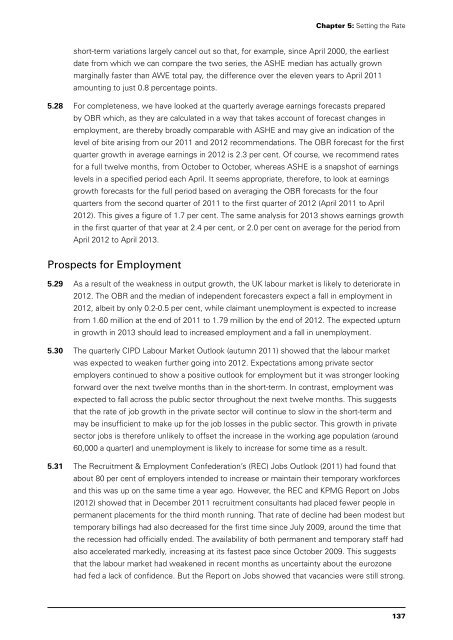National Minimum Wage
National Minimum Wage
National Minimum Wage
Create successful ePaper yourself
Turn your PDF publications into a flip-book with our unique Google optimized e-Paper software.
Chapter 5: Setting the Rate<br />
short-term variations largely cancel out so that, for example, since April 2000, the earliest<br />
date from which we can compare the two series, the ASHE median has actually grown<br />
marginally faster than AWE total pay, the difference over the eleven years to April 2011<br />
amounting to just 0.8 percentage points.<br />
5.28 For completeness, we have looked at the quarterly average earnings forecasts prepared<br />
by OBR which, as they are calculated in a way that takes account of forecast changes in<br />
employment, are thereby broadly comparable with ASHE and may give an indication of the<br />
level of bite arising from our 2011 and 2012 recommendations. The OBR forecast for the first<br />
quarter growth in average earnings in 2012 is 2.3 per cent. Of course, we recommend rates<br />
for a full twelve months, from October to October, whereas ASHE is a snapshot of earnings<br />
levels in a specified period each April. It seems appropriate, therefore, to look at earnings<br />
growth forecasts for the full period based on averaging the OBR forecasts for the four<br />
quarters from the second quarter of 2011 to the first quarter of 2012 (April 2011 to April<br />
2012). This gives a figure of 1.7 per cent. The same analysis for 2013 shows earnings growth<br />
in the first quarter of that year at 2.4 per cent, or 2.0 per cent on average for the period from<br />
April 2012 to April 2013.<br />
Prospects for Employment<br />
5.29 As a result of the weakness in output growth, the UK labour market is likely to deteriorate in<br />
2012. The OBR and the median of independent forecasters expect a fall in employment in<br />
2012, albeit by only 0.2-0.5 per cent, while claimant unemployment is expected to increase<br />
from 1.60 million at the end of 2011 to 1.79 million by the end of 2012. The expected upturn<br />
in growth in 2013 should lead to increased employment and a fall in unemployment.<br />
5.30 The quarterly CIPD Labour Market Outlook (autumn 2011) showed that the labour market<br />
was expected to weaken further going into 2012. Expectations among private sector<br />
employers continued to show a positive outlook for employment but it was stronger looking<br />
forward over the next twelve months than in the short-term. In contrast, employment was<br />
expected to fall across the public sector throughout the next twelve months. This suggests<br />
that the rate of job growth in the private sector will continue to slow in the short-term and<br />
may be insufficient to make up for the job losses in the public sector. This growth in private<br />
sector jobs is therefore unlikely to offset the increase in the working age population (around<br />
60,000 a quarter) and unemployment is likely to increase for some time as a result.<br />
5.31 The Recruitment & Employment Confederation’s (REC) Jobs Outlook (2011) had found that<br />
about 80 per cent of employers intended to increase or maintain their temporary workforces<br />
and this was up on the same time a year ago. However, the REC and KPMG Report on Jobs<br />
(2012) showed that in December 2011 recruitment consultants had placed fewer people in<br />
permanent placements for the third month running. That rate of decline had been modest but<br />
temporary billings had also decreased for the first time since July 2009, around the time that<br />
the recession had officially ended. The availability of both permanent and temporary staff had<br />
also accelerated markedly, increasing at its fastest pace since October 2009. This suggests<br />
that the labour market had weakened in recent months as uncertainty about the eurozone<br />
had fed a lack of confidence. But the Report on Jobs showed that vacancies were still strong.<br />
137


